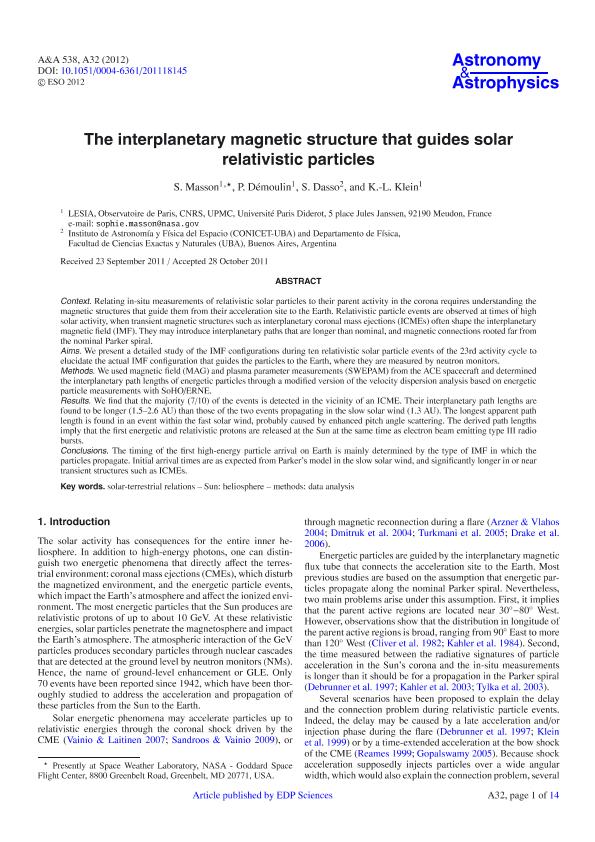Mostrar el registro sencillo del ítem
dc.contributor.author
Masson, S.
dc.contributor.author
Démoulin, Pascal

dc.contributor.author
Dasso, Sergio Ricardo

dc.contributor.author
Klein, K. L.
dc.date.available
2019-05-21T14:04:28Z
dc.date.issued
2012-01
dc.identifier.citation
Masson, S.; Démoulin, Pascal; Dasso, Sergio Ricardo; Klein, K. L.; The interplanetary magnetic structure that guides solar relativistic particles; EDP Sciences; Astronomy and Astrophysics; 538; 1-2012; 32-52
dc.identifier.issn
0004-6361
dc.identifier.uri
http://hdl.handle.net/11336/76776
dc.description.abstract
Context. Relating in-situ measurements of relativistic solar particles to their parent activity in the corona requires understanding the magnetic structures that guide them from their acceleration site to the Earth. Relativistic particle events are observed at times of high solar activity, when transient magnetic structures such as interplanetary coronal mass ejections (ICMEs) often shape the interplanetary magnetic field (IMF). They may introduce interplanetary paths that are longer than nominal, and magnetic connections rooted far from the nominal Parker spiral. Aims. We present a detailed study of the IMF configurations during ten relativistic solar particle events of the 23rd activity cycle to elucidate the actual IMF configuration that guides the particles to the Earth, where they are measured by neutron monitors. Methods. We used magnetic field (MAG) and plasma parameter measurements (SWEPAM) from the ACE spacecraft and determined the interplanetary path lengths of energetic particles through a modified version of the velocity dispersion analysis based on energetic particle measurements with SoHO/ERNE. Results. We find that the majority (7/10) of the events is detected in the vicinity of an ICME. Their interplanetary path lengths are found to be longer (1.5-2.6 AU) than those of the two events propagating in the slow solar wind (1.3 AU). The longest apparent path length is found in an event within the fast solar wind, probably caused by enhanced pitch angle scattering. The derived path lengths imply that the first energetic and relativistic protons are released at the Sun at the same time as electron beam emitting type III radio bursts. Conclusions. The timing of the first high-energy particle arrival on Earth is mainly determined by the type of IMF in which the particles propagate. Initial arrival times are as expected from Parker's model in the slow solar wind, and significantly longer in or near transient structures such as ICMEs. © 2012 ESO.
dc.format
application/pdf
dc.language.iso
eng
dc.publisher
EDP Sciences

dc.rights
info:eu-repo/semantics/openAccess
dc.rights.uri
https://creativecommons.org/licenses/by-nc-sa/2.5/ar/
dc.subject
Methods: Data Analysis
dc.subject
Solar-Terrestrial Relations
dc.subject
Sun: Heliosphere
dc.subject.classification
Astronomía

dc.subject.classification
Ciencias Físicas

dc.subject.classification
CIENCIAS NATURALES Y EXACTAS

dc.title
The interplanetary magnetic structure that guides solar relativistic particles
dc.type
info:eu-repo/semantics/article
dc.type
info:ar-repo/semantics/artículo
dc.type
info:eu-repo/semantics/publishedVersion
dc.date.updated
2019-05-14T21:19:38Z
dc.journal.volume
538
dc.journal.pagination
32-52
dc.journal.pais
Francia

dc.journal.ciudad
Paris
dc.description.fil
Fil: Masson, S.. Université Paris Diderot - Paris 7; Francia
dc.description.fil
Fil: Démoulin, Pascal. Université Paris Diderot - Paris 7; Francia
dc.description.fil
Fil: Dasso, Sergio Ricardo. Consejo Nacional de Investigaciónes Científicas y Técnicas. Oficina de Coordinación Administrativa Ciudad Universitaria. Instituto de Astronomía y Física del Espacio. - Universidad de Buenos Aires. Facultad de Ciencias Exactas y Naturales. Instituto de Astronomía y Física del Espacio; Argentina. Universidad de Buenos Aires. Facultad de Ciencias Exactas y Naturales. Departamento de Física; Argentina
dc.description.fil
Fil: Klein, K. L.. Université Paris Diderot - Paris 7; Francia
dc.journal.title
Astronomy and Astrophysics

dc.relation.alternativeid
info:eu-repo/semantics/altIdentifier/doi/http://dx.doi.org/10.1051/0004-6361/201118145
Archivos asociados
